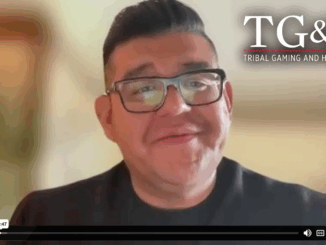By Michael Minniear, Chief Technology Officer, Power Promotions
When I first walked on stage at Raving’s Host and PD Conference this past July to “Panama,” I joked it was a Van Halen kind of day. Truth is, I was nervous. Not because of the crowd of casino pros staring back at me, but because, for the first time, my wife Amy was sitting in the audience. We met here back in 1994, when this place was nothing but dirt and trailers. My first job was as a janitor on the graveyard shift. So yes, you’re listening to a data nerd who once emptied ashtrays at 3 a.m. Keep your expectations reasonable.
Still, Amy reminded me of something important — she used to work for the tribal board here (she is now Pechanga’s treasurer), and she always showed deep appreciation to staff at those service awards dinners. She poured love onto the people doing the hard work. And that’s what I want to do for you today. Because the truth is, reinvestment is hard. It’s hard for analysts. It’s hard for hosts. It’s hard for all of us trying to make the right call with limited information, in the moment, while players are looking you in the eye.
Finance, wallets, and “The Double Whammy”
If you ask finance how much you should reinvest, the answer is simple: Nothing. Stop giving people money. Now, that’s a bad joke, but there’s a kernel of truth there. Research backs it up. University of Nevada, Las Vegas did a study where they dialed free play offers all the way up and all the way down, even to zero, and the impact on trip frequency was negligible. I’ve seen it myself, running bus programs — sometimes just putting the bus back on the road was more powerful than any offer we attached to it.
But we all know the reality is more complicated. Players expect reinvestment. They see themselves as “$1,000 players” or “$2,000 players” because that’s what they bring in their wallets. When you ask them what’s fair, they’ll tell you 10 – 20 percent of that amount. The problem? Our math values them at about 40 percent of their wallet. So they think they deserve $200, we’re calculating $80, and you’re the one in the middle. That’s what I call The Double Whammy: They lose their entire wallet quickly, then they get a low offer in the mail, and you’re the one left smoothing it over.
The 15-minute movie problem
Here’s something I can’t get out of my head. Most forms of entertainment last two to three hours. A movie, a concert, even a round of golf. Players expect the same from us. Yet in simulations, when I gave 5,000 players $300 to wager, 96 percent lost it all before five hours — and most lost it much sooner. Imagine paying today’s movie ticket prices, and the film ends after 15 minutes. That’s what too many of our guests experience.
The best players — the ones with longevity — do something different. They manage their bet-to-bankroll ratio. They stretch their play with smaller bets. Time-on-device is slippery for us to control, but time on property isn’t. That’s where we can step in — extend the day with experiences, not just offers.
It’s the experience, stupid (A nod to our dearly missed Michael Meczka’s “It’s the Gambling, Stupid”)
I learned a lot sitting in focus groups with players. Some moments were face-palms:
“Don’t make me work,” one VIP told me. He was tired of card errors, PIN resets, and waiting in line when all he wanted was to get to his game.
Another said, “I play most at the casino I like the least.” Why? Because it was closest. Proximity beats preference more often than we think.
One player hit two jackpots in a row — and was furious, not thrilled — because the hand-pay process was so slow.
And then there was Mary. She once had a terrible experience and told me she’d never come back. Two days later, I found her in high limit, happily spinning. Why? Because she had to pick up a hand mixer from a gifting promotion. That little appliance got her back through the door and back on the machines. That’s perceived value in action.
Rethinking reinvestment
So where does this leave us? I believe optimum reinvestment is about balance — not just money but also time and experience. Money matters, of course, but only when we leverage perceived value. A $200 golf round may cost us almost nothing to provide, but feels priceless to the guest. A well-chosen gift can cost $18 and feel like $100. Free soda, trail mix, even quick hand pays — these are the kinds of things that change the player’s memory of their trip.
Time matters because of the 15-minute movie problem. If we can’t extend playtime on the device, we can stretch the visit on property through events, activations, or simply a seamless, friction-free experience.
And finally, experience matters most. It’s the service, the security, the clean property, and the host who remembers their kids’ names. I’ve seen players follow hosts to new properties, even when the games are the same everywhere. Relationships matter that much.
“Play, play, play, and play! And eventually you’ll get to where you want to be.” – Van Halen
At the end of the day, yes, it’s the gambling. But it’s also the parking lot, the card reader, the host’s handshake, and yes — even the hand mixer. My hope is that we start looking at reinvestment through this broader lens: Not just the dollars we hand back, but the time and experiences we create that make a player want to come back tomorrow.
Because if there’s one lesson I’ve learned since those janitor shifts in the trailers, it’s this: Our job isn’t just to record the data. It’s to give people reasons to stay, to smile, and to return.





